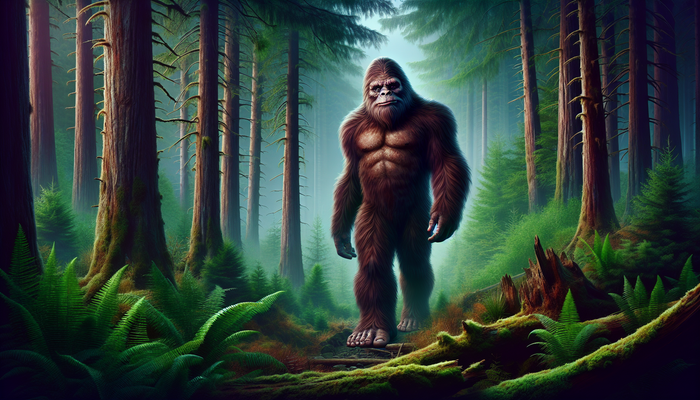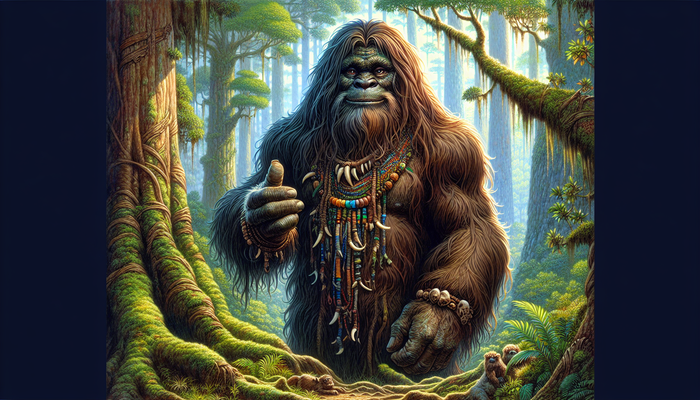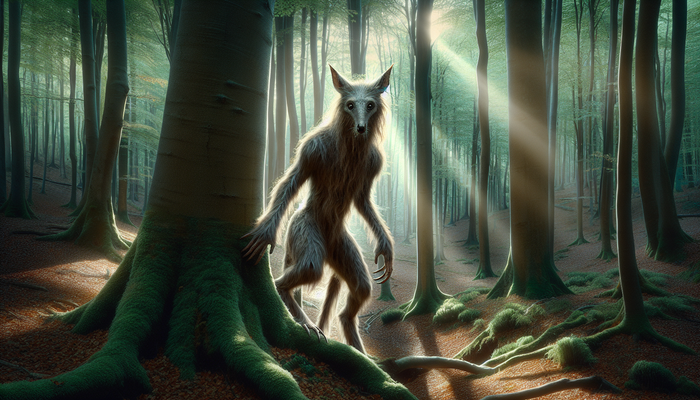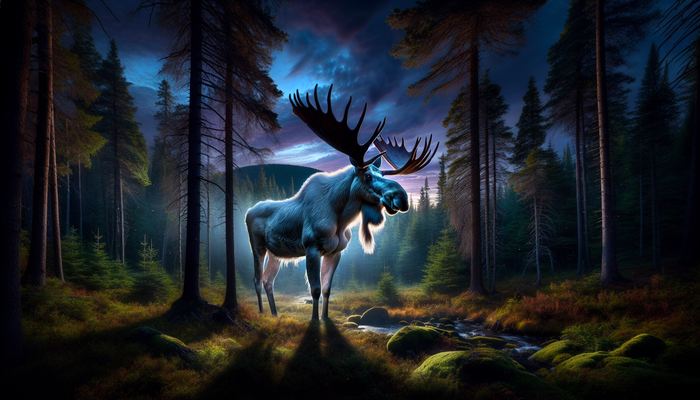Discover the Mysteries of New Hampshire Cryptid Legends

By Dr. Elizabeth Harper, Cryptozoologist
The Enigmatic Wood Devil: New Hampshire's Sasquatch
You're hiking through the dense forests of Coos County, New Hampshire. The air is crisp, the leaves rustle softly, and suddenly—you catch a glimpse of something tall and thin darting behind a tree. Was it just a trick of the light, or could it be the legendary Wood Devil?
The Wood Devil, often described as New Hampshire's answer to Bigfoot, is a creature that defies easy categorization. Standing an impressive 7 to 9 feet tall, this cryptid is no lumbering giant. Instead, witnesses describe a slender, agile being covered in shaggy gray or tan hair. Its most striking feature? A horse-like face with large, expressive eyes that seem to hold an otherworldly intelligence.
But what truly sets the Wood Devil apart from its cryptid cousins is its uncanny ability to blend into its surroundings. This isn't your average hide-and-seek champion—the Wood Devil is a master of camouflage, using the forest's natural elements to conceal itself with an almost supernatural skill. Witnesses report seeing it rotate around tree trunks to avoid detection, moving with a silence that belies its size.
The legend of the Wood Devil isn't just a recent phenomenon. Its roots stretch back to the early 20th century, with sightings spiking in the 1930s. One of the earliest documented encounters comes from 1948, when a hunter named George Lavoie had a close encounter that would chill anyone to the bone. Lavoie described seeing a tall, hairy creature with a horse-like face standing behind a tree near his hunting camp. Despite firing his rifle, the creature vanished without a trace, leaving behind only oversized footprints as evidence of its passage.
As the decades rolled on, the Wood Devil continued to make its presence known. The 1970s saw a particular surge in sightings, with hikers and outdoor enthusiasts reporting encounters that left them questioning everything they thought they knew about the natural world. One particularly vivid account comes from a group of campers who claimed to have heard bone-chilling screams echoing through the forest at night, followed by the sight of a tall, gray figure moving with impossible speed through the underbrush.
But why "Wood Devil"? The name itself speaks volumes about the creature's reputation. Early lumberjacks and settlers in the region, spooked by glimpses of this unknown being, dubbed it with a moniker that reflected both its habitat and the fear it inspired. Yet, despite its intimidating name, reports of aggressive behavior are rare. The Wood Devil seems more intent on avoiding human contact than causing harm, leading some researchers to speculate that it might be a shy, intelligent species rather than the monster its name suggests.
The cultural impact of the Wood Devil on New Hampshire cannot be overstated. It's become a symbol of the wild, untamed aspects of the state's forests—a reminder that there are still mysteries to be solved and discoveries to be made. Local businesses have embraced the legend, with Wood Devil-themed attractions and merchandise becoming popular among tourists and cryptid enthusiasts alike.
But the Wood Devil is more than just a tourist draw. For many, it represents the enduring mystery of the natural world, a challenge to our understanding of what's possible. Cryptozoologists and amateur researchers continue to scour the forests of Coos County, armed with cameras and an unshakeable belief that the truth is out there, waiting to be uncovered.
As we ponder the existence of the Wood Devil, it's worth considering the words of a local forest ranger who's spent decades in the New Hampshire wilderness: "I've seen things out there that I can't explain. The forest has secrets, and maybe, just maybe, the Wood Devil is one of them. Until we know for sure, these woods will always hold a bit of magic and mystery."
The Terrifying Devil Monkey: A Primate Out of Place
If the Wood Devil represents the mysterious and elusive side of New Hampshire's cryptids, the Devil Monkey embodies pure, primal terror. This creature, reported to inhabit the forests and rural areas of the state, is a far cry from the cuddly primates you might see at the zoo. Instead, imagine a beast that combines the worst aspects of a baboon and a wolf, with a dash of nightmare fuel thrown in for good measure.
Descriptions of the Devil Monkey paint a picture of a creature that seems almost designed to inspire fear. Standing anywhere from 3 to 8 feet tall, it boasts a dog-like snout filled with razor-sharp teeth, pointed ears that swivel to catch the slightest sound, and most disturbingly, long, powerful arms ending in vicious claws. Its body is covered in dark hair, often described as reddish-brown or black, with some reports mentioning a distinctive white patch on its underbelly.
But it's not just the Devil Monkey's appearance that sends shivers down the spine—it's its behavior. Unlike the shy and reclusive Wood Devil, this cryptid is known for its aggression. Reports often include accounts of the creature attacking livestock, pets, and even pursuing humans with a relentless determination that seems more fitting for a horror movie monster than a flesh-and-blood animal.
The legend of the Devil Monkey reached fever pitch in 2001 in the small town of Danville, New Hampshire. It was here that a series of sightings over a two-week period sent the community into a state of panic. The first and most credible report came from none other than the town's fire chief, David Kimball. Kimball, a man not prone to flights of fancy, described seeing a large, reddish-brown primate leap out of the woods and onto the road in front of his vehicle. The creature, he said, moved with an agility that defied belief, bounding away into the forest with incredible speed.
In the days that followed, more reports flooded in. Residents spoke of hearing unearthly howls in the night, finding strange tracks in their yards, and glimpsing a dark, simian shape moving through the trees at the edge of their properties. Parents, understandably terrified, refused to let their children play outside after dark. The local media had a field day, dubbing the creature the "Danville Devil Monkey" and sparking a frenzy of speculation about its origins and nature.
The town's response to the Devil Monkey sightings was a mix of fear and fascination. Some residents armed themselves, while others organized search parties to try and capture or at least photograph the elusive beast. Local animal control officers were inundated with calls, and even a few cryptozoologists made the journey to Danville, hoping to gather evidence of this out-of-place primate.
One of the most intriguing aspects of the Devil Monkey phenomenon is the variety of theories put forward to explain its existence. Some speculate that it could be an escaped exotic pet, perhaps a baboon or a large macaque that had adapted to life in the wild. Others propose more fantastical explanations, suggesting that the Devil Monkey might be a relic population of an unknown primate species that has somehow survived undetected in the forests of New England for centuries.
The scientific community, unsurprisingly, remains skeptical. Primatologists point out that no known species of monkey could survive the harsh New Hampshire winters without human intervention. They suggest that the sightings might be misidentifications of other animals, such as black bears standing on their hind legs or even large feral dogs.
Yet, the legend persists. Even years after the Danville incident, reports of Devil Monkey sightings continue to trickle in from various parts of New Hampshire and neighboring states. Each new account adds another layer to the mystery, keeping the legend alive in the public imagination.
The impact of the Devil Monkey on local culture has been significant. It's become a part of New Hampshire folklore, a cautionary tale told around campfires and a source of both fear and excitement for those venturing into the state's wilderness areas. Some local businesses have even capitalized on the legend, offering Devil Monkey-themed tours and merchandise to curious visitors.
As one local folklorist put it, "Whether the Devil Monkey is real or not, it's become a part of our cultural DNA here in New Hampshire. It reminds us that there's still wildness out there, still things we don't understand. And in a world where everything seems mapped and explained, isn't there something thrilling about that?"
The Dublin Lake Monster: Mysteries Beneath the Surface
From the forests to the depths, New Hampshire's cryptid lore takes a plunge into the murky waters of Dublin Lake with tales of a creature that could rival the famous Loch Ness Monster. The Dublin Lake Monster, a lesser-known but equally intriguing cryptid, adds a aquatic dimension to the state's menagerie of mysterious beings.
Dublin Lake, nestled in the town of Dublin in Cheshire County, seems an unlikely home for a monstrous creature. With its picturesque shores and clear waters, it's a popular spot for fishing, boating, and summer recreation. But beneath its tranquil surface, some believe, lurks a beast that defies explanation and has the power to drive those who encounter it to the brink of madness.
Descriptions of the Dublin Lake Monster are as varied as they are fantastical. Some accounts paint it as a massive, eel-like creature, its sinuous body stretching to lengths of 30 feet or more. Others describe it as more reptilian, with a long neck and small head reminiscent of the popular image of the Loch Ness Monster. But what sets the Dublin Lake Monster apart from other lake cryptids is the psychological effect it's said to have on those who encounter it.
The most chilling aspect of the Dublin Lake Monster legend revolves around a series of incidents in the 1980s. According to local lore, a scuba diver exploring the lake's depths went missing during a routine dive. Days later, in a twist that could have come straight from a horror novel, the diver was found naked and incoherent in the woods near the lake, babbling about monstrous creatures dwelling in underwater caverns.
This incident spawned a variety of theories and elaborations. Some versions of the story claim that the diver spoke of air-filled caves deep beneath the lake's surface, home to creatures so hideous that merely gazing upon them could drive a person to insanity. Others suggest that the monster possesses some form of psychic ability, able to project terrifying visions into the minds of those who venture too deep into its domain.
While skeptics might dismiss these tales as nothing more than campfire stories or the result of diving accidents and oxygen deprivation, the legend has taken on a life of its own. It's become intertwined with the identity of Dublin Lake, adding a layer of mystery and excitement to what might otherwise be just another New England water body.
The impact of the Dublin Lake Monster on the local community has been significant. Some residents embrace the legend, seeing it as a unique part of their town's heritage. Others view it with a mix of amusement and exasperation, tired of the attention it brings from monster hunters and thrill-seekers.
Local businesses, however, have found ways to capitalize on the creature's notoriety. Souvenir shops offer Dublin Lake Monster merchandise, from t-shirts to stuffed toys. Some enterprising tour operators even offer "monster-spotting" boat trips, though they're careful to frame these excursions as entertainment rather than serious expeditions.
The scientific community has, unsurprisingly, remained skeptical of the Dublin Lake Monster's existence. Limnologists and marine biologists point out that the lake, while deep, is simply too small to support a breeding population of large, unknown animals. They suggest that sightings might be misidentifications of known species like large fish or swimming mammals, or optical illusions caused by waves and floating debris.
Yet, the legend persists, fueled by occasional reports of strange sightings and unexplained phenomena. One local fisherman, who wished to remain anonymous, shared a particularly vivid account: "I was out on the lake early one morning, just as the mist was rising off the water. Suddenly, I saw something break the surface about fifty yards away. It was huge, like a giant snake, but with a head almost like a horse. It looked right at me with these big, intelligent eyes, and I swear I felt it in my mind. Then it sank back down, and the water was calm like nothing had happened. I've been fishing these waters for forty years, and I've never seen anything like it before or since."
Stories like these keep the mystery alive, challenging our understanding of the natural world and reminding us that even in the most seemingly ordinary places, the extraordinary might be lurking just out of sight. The Dublin Lake Monster serves as a reminder that the world still holds secrets, that there are still frontiers to be explored, even if they're in our own backyards.
As one local historian put it, "The Dublin Lake Monster is more than just a creature—it's a symbol of the unknown, a challenge to our assumptions about what's possible. In a world where we think we've got everything figured out, it's refreshing to have a mystery that defies easy explanation. Whether it's real or not, the monster keeps our sense of wonder alive, and that's a valuable thing in this day and age."
The Dover Demon: A Close Encounter of the Cryptid Kind
While not strictly a New Hampshire native, the Dover Demon's proximity and impact on New England cryptid lore make it a crucial part of our exploration. This bizarre creature, reported in the town of Dover, Massachusetts, just a stone's throw from the New Hampshire border, has become one of the most intriguing and puzzling cryptids in the region.
The story of the Dover Demon begins on a spring night in 1977, setting the stage for a series of encounters that would captivate the nation and spawn decades of speculation. On April 21st, 17-year-old Bill Bartlett was driving along Farm Street in Dover when he saw something that would change his life forever. Perched on a stone wall at the side of the road was a creature unlike anything he had ever seen before.
Bartlett described the being as having a watermelon-shaped head, about the size of the rest of its body. Its skin was hairless and peach-colored, with a rough texture like sandpaper. But it was the creature's eyes that truly struck fear into the young man's heart—glowing, orange orbs that seemed to pierce right through him. The body was thin and spindly, with long, slender fingers and no visible mouth or nose.
What makes the Dover Demon case particularly compelling is that Bartlett wasn't the only one to see it. Within a 25-hour period, two other teenagers reported similar sightings. John Baxter, 15, encountered the creature while walking home from his girlfriend's house. He described a similar being, adding that it had tendril-like fingers and seemed to be cowering, as if afraid.
The final sighting came from 15-year-old Abby Brabham, who was riding in a car with 18-year-old Will Taintor. They spotted what they described as a hairless creature with elongated limbs and a large, oval head, its eyes seeming to glow in the car's headlights.
The consistency in these independent accounts, coming from witnesses who had no prior contact with each other, lends a degree of credibility to the Dover Demon sightings that many other cryptid reports lack. Each witness was interviewed separately and asked to draw what they had seen. The resulting sketches were remarkably similar, adding another layer of intrigue to the case.
The Dover Demon sightings caused a media sensation. Reporters descended on the small town, and the creature quickly became a national news story. Cryptozoologists and UFO researchers alike were drawn to the case, seeing in the Dover Demon a potential link between cryptid sightings and alien encounters.
One of the most prominent researchers to investigate the Dover Demon was Loren Coleman, a well-known cryptozoologist. Coleman interviewed the witnesses and coined the term "Dover Demon," which quickly caught on in the media and popular culture. He noted the creature's similarity to the "gray" aliens of UFO lore, as well as its resemblance to certain cryptids reported in other parts of the world.
Theories about the Dover Demon's nature and origin run the gamut from the mundane to the fantastic. Some skeptics suggest that the witnesses might have seen a young moose or a foal, their perceptions distorted by the darkness and their own fear. Others propose that it could have been an escaped exotic pet, perhaps a type of monkey or lemur unfamiliar to New England residents.
More outlandish theories link the Dover Demon to extraterrestrial visitations or interdimensional travel. Some ufologists have suggested that the creature might be a type of alien probe or biological robot sent to explore Earth. Others see it as evidence of parallel universes or hidden dimensions intersecting with our own.
The impact of the Dover Demon on popular culture has been significant. It has been featured in numerous books, television shows, and even comic books. The creature has become a staple of cryptid lore, often mentioned alongside more famous cryptids like Bigfoot and the Loch Ness Monster.
In Dover itself, the legacy of the Demon is more complex. Some residents embrace the notoriety, seeing it as a unique part of their town's history. Others prefer not to discuss it, wary of the attention it brings or skeptical of the whole affair. Nevertheless, the Dover Demon has become an indelible part of local folklore, a story passed down through generations.
What sets the Dover Demon apart from many other cryptids is the short duration of its appearance. Unlike creatures like Bigfoot or the Jersey Devil, which have histories stretching back decades or even centuries, the Dover Demon was seen only during that brief 25-hour window in April 1977. This has led some researchers to speculate that the creature might have been a temporary visitor to our reality, perhaps slipping through some sort of interdimensional portal.
The Dover Demon case raises fascinating questions about the nature of perception, memory, and the unknown. How do we reconcile eyewitness accounts of something that seems impossible with our understanding of the natural world? What does it say about human psychology that such a brief series of encounters could have such a lasting impact on our collective imagination?
As one local paranormal investigator put it, "The Dover Demon represents the perfect cryptid mystery. We have multiple, credible witnesses. We have detailed descriptions and drawings. But we also have a complete lack of physical evidence and no further sightings. It's like the creature appeared just long enough to make us question everything we think we know about reality, then vanished back into the unknown."
Whether the Dover Demon was a misidentified animal, an alien visitor, or something even stranger, its brief appearance has left an indelible mark on the cryptid landscape of New England. It serves as a reminder that even in the most ordinary places, extraordinary things can happen—if only we keep our eyes open and our minds receptive to the possibilities.
The Oapi Owl Man: A Feathered Enigma
Deep in the forests of Oapi, New Hampshire, lurks a creature that seems to bridge the gap between the natural and the supernatural. The Oapi Owl Man, a lesser-known but equally intriguing cryptid, adds yet another layer of mystery to the state's rich tapestry of unexplained phenomena.
Descriptions of the Oapi Owl Man paint a picture of a being that defies easy categorization. Witnesses report seeing a humanoid figure standing between 6 and 8 feet tall, covered in feathers rather than fur. Its most striking feature is its head, which bears an uncanny resemblance to that of an owl, complete with large, round eyes that seem to glow in the darkness. Some accounts mention wings, while others describe arm-like appendages covered in feathers.
The creature's behavior is as enigmatic as its appearance. Unlike the aggressive Devil Monkey or the elusive Wood Devil, the Oapi Owl Man seems to occupy a middle ground. Witnesses often report feeling watched rather than threatened, describing a sense of eerie curiosity emanating from the creature.
One of the most compelling accounts comes from a hiker who encountered the Oapi Owl Man in the late 1990s. The witness, who wished to remain anonymous, described the experience: "I was on a solo camping trip, setting up my tent just as dusk was falling. I had this intense feeling of being watched, and when I turned around, there it was. It was standing maybe 30 feet away, partially hidden behind a tree. The eyes were what got me—huge and round, reflecting the last bit of daylight. We just stared at each other for what felt like an eternity. Then it let out this sound, like a mix between an owl's hoot and a human moan, and just... melted into the shadows. I didn't sleep a wink that night."
This account, like many others, highlights the Oapi Owl Man's apparent ability to move silently through the forest and disappear at will. Some researchers have speculated that this could be due to some form of natural camouflage, while others suggest more paranormal explanations, such as the ability to shift between dimensions.
The origins of the Oapi Owl Man legend are somewhat murky. Some folklorists trace it back to Native American legends of shape-shifting creatures that could take on both human and animal characteristics. Others see connections to European folklore, particularly stories of owl-like creatures associated with wisdom and hidden knowledge.
Interestingly, the Oapi Owl Man shares some characteristics with other cryptids reported around the world. The Mothman of Point Pleasant, West Virginia, for example, is often described as having owl-like features. Similarly, the Batsquatch of Washington state is said to have both bat and owl characteristics. These similarities have led some researchers to speculate about a possible connection between these creatures, perhaps representing different manifestations of the same phenomenon.
The impact of the Oapi Owl Man on local culture has been subtle but significant. Unlike some of the more famous cryptids, which have become tourist attractions or local mascots, the Owl Man remains a more personal, intimate part of Oapi's folklore. It's a story shared around campfires, a tale that makes people look twice when walking in the woods at twilight.
One local artist, inspired by the legend, created a series of haunting paintings depicting the Oapi Owl Man. The works, which hang in the town's small gallery, capture the creature's otherworldly quality—part animal, part something else entirely. "I wanted to convey that sense of mystery," the artist explained. "The idea that there's something out there that we can't quite understand, something that challenges our perception of what's possible."
Skeptics, of course, have their own explanations for the Oapi Owl Man sightings. Some suggest that witnesses might be misidentifying large owls, particularly the great horned owl, which can stand up to 2 feet tall and has a distinctive silhouette. Others point to the power of suggestion and the human tendency to see patterns and faces in natural phenomena, a psychological quirk known as pareidolia.
Yet, for many in Oapi and the surrounding areas, the Owl Man represents something more than just a case of mistaken identity. It's a symbol of the enduring mystery of the natural world, a reminder that there are still things out there that we don't fully understand.
As one local naturalist put it, "Whether the Oapi Owl Man is real in a physical sense or not, it's real in its impact on how we view our forests. It makes people pay attention, makes them look more closely at their surroundings. And in doing so, they often discover the very real wonders of nature that are all around us. In that sense, the Owl Man serves a valuable purpose, keeping our sense of wonder alive."
The legend of the Oapi Owl Man continues to evolve, with new sightings and stories adding to its mystique. It stands as a testament to the power of folklore to shape our perceptions of the world around us, blending the natural and the supernatural into something that captures the imagination and challenges our understanding of reality.
The Dog Man: A Canine Conundrum
In the annals of New Hampshire's cryptid lore, few creatures inspire as much fear and fascination as the Dog Man. This beast, which seems to blur the line between canine and human, has been the subject of whispered tales and fireside stories for generations, its legend growing with each reported sighting.
The Dog Man is typically described as a bipedal creature standing between 6 and 8 feet tall, with the body of a man but the head of a large canine, most often compared to a wolf or a German shepherd. Witnesses report seeing muscular, hair-covered bodies, powerful legs built for running, and most disturbingly, hands with opposable thumbs, often tipped with sharp claws. But it's the creature's eyes that seem to leave the deepest impression—described as glowing with an eerie, intelligent light that seems far too knowing to belong to a mere animal.
Reports of Dog Man sightings in New Hampshire date back to the early days of European settlement, with some researchers suggesting that Native American legends of shape-shifters and skin-walkers may have influenced or even originated from encounters with these creatures. One of the earliest recorded sightings comes from a journal entry dated 1778, written by a farmer living near what is now Franconia Notch State Park.
The farmer wrote: "Saw today a most peculiar beast at the edge of the wood. It stood upright like a man, yet had the head of a great hound. Its eyes glowed like embers in the twilight. When it saw me, it let out a howl that chilled my very soul, then ran into the forest on two legs, swift as the wind. I fear to speak of this to my neighbors, lest they think me mad or drunk, yet I know what I saw was no natural thing."
This account set the template for many Dog Man sightings to follow—a creature that seems to exist in the liminal space between human and animal, often spotted at the edges of civilization, as if it were some sort of guardian or watcher of the wilderness.
One of the most dramatic modern encounters with the Dog Man occurred in the White Mountains in the summer of 1992. A group of hikers, setting up camp for the night, reported hearing strange, guttural noises coming from the surrounding forest. Thinking it might be a bear, they prepared to secure their food, only to be confronted by a sight that defied explanation.
One of the hikers, John (name changed for privacy), recounted the experience: "It came out of the trees about 50 yards from our campsite. At first, I thought it was a man, maybe a homeless person or another hiker. But as it got closer, I realized something was very wrong. Its proportions were all off, and its head... God, its head was like a huge dog's, but with teeth that looked razor-sharp. It stood there, staring at us, and I swear it was thinking, calculating. Then it just turned and loped off into the woods. We packed up and hiked out that night, didn't even wait till morning. I've been an avid hiker for 30 years, and I've never seen anything like it before or since."
This account, like many others, highlights the unsettling intelligence that witnesses often attribute to the Dog Man. It's not just a wild animal, they insist, but something that seems to possess reasoning capabilities, perhaps even a form of communication.
Theories about the nature and origin of the Dog Man are as varied as the sightings themselves. Some cryptozoologists speculate that it could be a remnant population of an unknown species of primate, perhaps one that evolved to fill a niche similar to that of wolves or wild dogs. Others suggest it might be the result of genetic experimentation, either by clandestine government programs or even extraterrestrial visitors.
More supernatural explanations link the Dog Man to werewolf legends, proposing that it might be a creature capable of shifting between human and canine forms. Some paranormal researchers even suggest that the Dog Man might be a manifestation of collective human fears and anxieties, a sort of tulpa or thought-form brought into being by the power of belief.
Skeptics, of course, have their own explanations. They point out that many Dog Man sightings occur in low-light conditions or at great distances, making misidentification of known animals like bears or wolves more likely. The power of suggestion and the human tendency to pattern-match and anthropomorphize could account for the more fantastical elements of the reports, they argue.
Yet the legend persists, woven into the fabric of New Hampshire's folklore.
From Bigfoot to UFOs: Hangar 1 Publishing Has You Covered!
Explore Untold Stories: Venture into the world of UFOs, cryptids, Bigfoot, and beyond. Every story is a journey into the extraordinary.
Immersive Book Technology: Experience real videos, sights, and sounds within our books. Its not just reading; its an adventure.



























